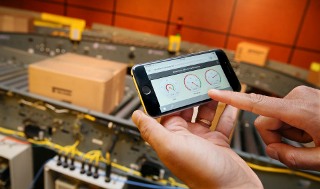Industrial workers are increasingly turning to mobile devices to improve productivity and collaboration. However, interfaces need to be tailored to the specific device that is being used, especially to design, operate and maintain industrial automation systems. To meet this user preference, Rockwell Automation and Microsoft Corp. are announcing a mobility co-innovation project designed for industrial environments where a wireless network connection is not always reliable.
 Industrial workers are increasingly turning to mobile devices to improve productivity and collaboration. A new mobility co-innovation project, designed for industrial settings by Rockwell Automation and Microsoft Corp., will be demonstrated at the Automation Fair event in Chicago, Nov. 18 and 19. (Photo: Business Wire)
Industrial workers are increasingly turning to mobile devices to improve productivity and collaboration. A new mobility co-innovation project, designed for industrial settings by Rockwell Automation and Microsoft Corp., will be demonstrated at the Automation Fair event in Chicago, Nov. 18 and 19. (Photo: Business Wire)
The co-innovation brings together leading IP technology from Project Thali (@Thaliproject), an open-source solution incubated by Microsoft. It also includes JXcore from Nubisa Inc., and complements the expanding mobile foundation toolkit from Rockwell Automation. The toolkit enables Rockwell Automation offerings with a consistent web-based user interface for a specific device; tablet, smartphone or desktop and now includes a prototype app, dubbed Project Stanton (@Project_Stanton). Both the product toolkit adopters and a new app prototype will be demonstrated at the Automation Fair event in Chicago, Nov. 18 and 19.
“Project Stanton represents the most forward and innovative thinking in the industry when it comes to mobility and a modern, mobile-first architecture,” said Sujeet Chand, chief technology officer, Rockwell Automation. “Microsoft, Nubisa and Rockwell Automation have made significant investments to deliver unprecedented value to industrial users through innovation and leveraging computing power in mobile devices to overcome the existing boundaries and limitations in anytime, anywhere access to valuable information in an enterprise.”
“Microsoft has partnered with Rockwell Automation to look at some of the most difficult challenges in industrial IoT,” said John Shewchuk, Technical Fellow, Microsoft. “Rockwell Automation is one of the leaders in the field and so it has been great to work on Project Stanton. Our joint work has been instrumental in setting the direction for the Thali Project work to provide secure peer-to-peer communications and improve industrial productivity.”
The mobility developments support The Connected Enterprise vision: the convergence of operations and information technology that will deliver the next wave of manufacturing productivity. Enhanced by the emergence of the Industrial Internet of Things and advances in enabling technologies – including mobility, data analytics, and remote monitoring – The Connected Enterprise creates opportunities for unprecedented benefits in productivity and global competitiveness through greater connectivity and information sharing.
“The Connected Enterprise is an imperative to face future competitiveness challenges at many levels,” said Chand. “Not only is this vision important to meet ongoing macroeconomic challenges, but it is critical for almost every type of manufacturer to drive new heights of competitive differentiation. Our co-innovation with Microsoft is one way that customers can build their Connected Enterprise.”